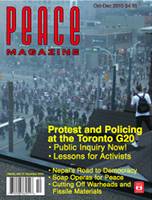
Peace Magazine Oct-Dec 2010, page 4. Some rights reserved.
Search for other articles by Ken Simons here
The G8 and G20 summits, which brought world leaders to Huntsville and Toronto, Ontario in late June, were not very remarkable as economic summits go. At what was billed the “austerity summit,” the recommendations included cutting annual government budget deficits in half by 2013 (for the developed economies) and reducing the debt-to-GDP ratio in all the participating economies by 2016. Banks would not be uniformly taxed for the costs of economic recovery (which in many cases meant “their role in causing the 2008 economic meltdown”). Rather, it would be up to each country to regulate and tax their own banks as they saw fit—a policy aggressively pushed by host leader Stephen Harper.
For many of our readers, though, the big story wasn’t the thin-as-air final communiqués, or the continued marginalization of the developing world. No, the story was the police. After spending $1.2 billion on preparations for the two summits (the largest slice by far devoted to providing security for world leaders who would meet for a day and a half behind a security fence in downtown Toronto) police found themselves arresting a lot of harmless people, some of them peaceful protesters, some of them just passsersby, and a very small number of them young people in black t-shirts and balaclavas—the notorious Black Bloc.
Two of our writers examine the G20 protests in this issue: Ron Shirtliff looks at the evidence for a public inquiry, while Lyn Adamson argues for the need to reclaim nonviolence, rather than “diversity of tactics,” as our central organizing principle.
Ken Simons
managing editor *

Peace Magazine Oct-Dec 2010, page 4. Some rights reserved.
Search for other articles by Ken Simons here